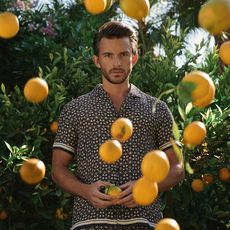How Pop Art Changed the World
To celebrate the launch of our latest capsule, we consider some 20th century revolutionaries
The British Museum Previews The American Dream: Pop To Present Exhibition, Carl Court © Getty Images
It was 1952, 7 years after the war, and London was still grey, cold and hungry. It was a fact not lost on a group of enigmatic young artists and architects who were increasingly growing tired of the conventions and strictures of post-war Britain. They didn’t know it then, but they were about to become revolutionaries. This disparate group of men and women had noted a strange juxtaposition between the drab bomb-pocked capital and the first springs of a brightly coloured consumerist society. So, they began to incorporate these bold new advertisements into their work in a way previously unthinkable. Pop Art was born.
“Mostly coming of age after the Second World War, these artists were only marginally affected by its traumas,” writes Flavia Frigeri in Pop Art, published by Thames & Hudson. “Instead they were able to indulge in the product frenzy and image deluge brought about by a rapidly growing consumer society.” Here were artists that claimed to worship the cola bottle and the soup can, who took inspiration from celebrity, advertising and consumer culture; they were ironic and rejected the conventional. Nothing would be the same again.
Pop might have started with Richard Hamilton and Eduardo Paolozzi (the artists) and Alison and Peter Smithson (the architects), but it would grow into a world-girdling movement that included names such as Andy Warhol, Roy Lichtenstein, James Rosenquist, and Claes Oldenburg. Though it started in Britain, it grew into a form that is most readily associated with America. “The language of Pop Art was soon redeployed across the globe” as Frigeri puts it. It would not only change art, but change the world as a whole, reaching deep into the culture and changing our notions of fame, literature and fashion.
With the rise of mass media in the 50s and 60s, the world was plastered with images – on TV screens, newspapers and in cinemas. They became universal in a way they were not before. Pop took these images – from Mao, to Donald Duck, to Mickey Mouse and Che Guevara – and began to invest them with something revolutionary: equal importance. “Pop Art looks out into the world. It doesn't look like a painting of something, it looks like the thing itself,” said Lichtenstein.
Lincoln Convertible by Gerald Laing in 1964 portrays the 1963 assassination of JFK in a way previously unthinkable. Here history and art intersect, contort, morph. JFK’s body is shown in colourful dots; the green is reduced to a square behind the car. Sixteen Jackies, a 1964 piece by Warhol followed Laing’s and showed repeating images of JFK’s wife, Jackie Kennedy, before and after JFK’s assassination. Both artists displayed a public dissection of grief for the world to see. Up until this point these pieces would both have been shocking to the public – acts of lèse-majesté or at least bad taste – but this was the reality of the TV world. Why should the images not be used in art if they are used by television?
This sense of reflecting turmoil in the world and turning it into art is sometimes found in unusual places. A surprising carrier of the torch of Pop Art was the Catholic nun, Sister Corita Kent. “In light of the tumultuous events … Corita felt compelled to voice her anguish through silkscreen-printing,” Frigeri writes. Cue bright green and red silk screens incorporating news cuttings about the Vietnam War alongside other events – a sort of newspaper remix.
As this sensibility seeped still deeper into the culture, it inevitably showed itself in fashion. There was a synergy with art itself – The Souper Dress, being the supreme example, a paper dress made out of repeated motifs of Warhol’s soup cans, sold for $1 each. It was the essence of Pop – both art and advertising, and open to mass consumption. The legacy of Pop Art would lay long on fashion – Yves Saint Laurent produced a show in 1966 titled the Pop Art collection, and even now Nike and Vans incorporate Lichtenstein’s comic panels on their trainers. If anything, Pop Art didn’t just impact fashion – it never left it. Which is one of the reasons why we have created a capsule inspired by Pop Art. which features our ‘Botany’ ‘Pop’ and ‘Rushy’ prints taken from the Design Library and reworked by our in-house designers ¬– our homage to those bold-face art names.
Perhaps the king of pop, whose Montauk home also partly inspired our Atlantic Coast collection, was Andy Warhol. Warhol created the banana cover for the Velvet Underground’s iconic “The Velvet Underground & Nico”. But he also came up with the idea behind Exploding Plastic Inevitable – live shows where the Velvet Underground’s music combined with Warhol’s films shown on projections. In essence they were the beginnings of what we now know as stadium tours and live visuals. And we all know how his dictum about everyone having their fifteen minutes of fame impacted the world. Or at least you do if you ever watched Keeping Up With the Kardashians, Big Brother or any of the other myriad reality TV programmes in the world. Few other art movements of the 20th century could claim to still have such palpable effect on the way we live now.
It was this matching of mass-produced information and mass consumption that meant that Pop Art infiltrated all manner of aspects of society. The banal entered art’s lexicon; Pop Art was sarcastic, a parody, a tongue-in-cheek wink at consumerism – and we like it.


